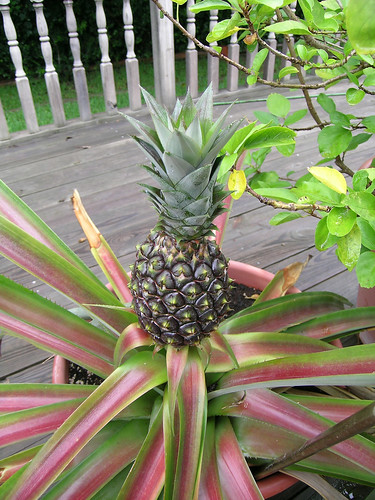 Looking for something to spice up your office or home interior? Add a little green (and sometimes pink) to your environment with a new, free houseplant. Pineapples make great houseplants; they don't attract bugs, they don't require much care, and they're incredibly easy to grow. Have a cat that chews on every plant or flower you bring into the house? No worries, the pointy, thick leaves of a pineapple plant won't interest them. And, if you treat your pineapple plant well, you may even be rewarded with a cute little (edible) baby pineapple.
Looking for something to spice up your office or home interior? Add a little green (and sometimes pink) to your environment with a new, free houseplant. Pineapples make great houseplants; they don't attract bugs, they don't require much care, and they're incredibly easy to grow. Have a cat that chews on every plant or flower you bring into the house? No worries, the pointy, thick leaves of a pineapple plant won't interest them. And, if you treat your pineapple plant well, you may even be rewarded with a cute little (edible) baby pineapple.Here how you do it:
Next time you buy a pineapple at your local grocery or farmer's market, make sure it has a nice green top. The leaves shouldn't pull out easily, and the bottom of the pineapple should smell strong and sweet. If your pineapple is still a bit green, no problem, just perch it upside down (to help it ripen evenly) in a windowsill when you get home and wait a few days for it to turn yellow. If it's just a tiny bit green, it's probably just fine to eat. An overripe pineapple is not a pretty, or tasty, thing.
When you're ready to eat it, use a towel or garden glove to grab the whole green top and twist is gently off. Don't pull, just twist. If you're lucky, your pineapple top will already have some rootage going on, like in the photo below, or at least a row or two of root nubs.

Then, cut off the little bit of fruit left on the stump with a knife and, starting with the lowest set of leaves (usually brown and dried), rip off the several bottommost rows of leaves until your pineapple plant will sit nicely in a jar of water with the stump immersed. Set your new plant and its jar in a window (it doesn't have to be very sunny) and wait. In a week or two, your new little friend should have enough roots to plant in a pot, or even directly in the ground.
 Pineapple #1 after a few days in water on the windowsill.
Pineapple #1 after a few days in water on the windowsill. Pineapple #2 after a few days in water on the windowsill.
Pineapple #2 after a few days in water on the windowsill.Once your little friend has established an inch or so of roots all around, he's ready to be planted. You can use potting soil, but mine did fine in just regular dirt. You can start with a little 6" pot, like I have and repot as it grows, or you can put it directly in a larger pot (20" or so ought to do it) so you won't have to move it.
Pineapple plants like full sun to partial shade, warm weather, and moderate watering. Keep the soil moist, but don't overwater. If you live in an area that gets cool, bring your potted pineapple inside when it starts to get cold, way before any danger of frost. Pineapples are hardy, but they are tropical plants.
 First pineapple in the ground, just planted.
First pineapple in the ground, just planted. First pineapple (front) still doing well, now accompanied by four others (along with some rosemary and wild chayote).
First pineapple (front) still doing well, now accompanied by four others (along with some rosemary and wild chayote).I now have one pineapple plant in a little pot and six lining the fence in my backyard. I have to choose wisely what I plant along this fence because there are often cows grazing on the other side of it. I'm fairly confident they won't want to chomp on sharp, slightly serrated pineapple leaves, and tiny, needle-like rosemary leaves, but the chayote I'm not sure about. But it just popped up there, so there's no point in pulling it out.
Pineapple plants take at least a year, usually two, to bear fruit, so be patient. In the meantime, your living space will benefit from your pretty new houseplant and some extra, freshly created oxygen.
Pineapple plants take at least a year, usually two, to bear fruit, so be patient. In the meantime, your living space will benefit from your pretty new houseplant and some extra, freshly created oxygen.































3 comments:
What a wonderful post. That's a great idea; I'm going to try it. Thank you for sharing.
I have got to try this!! Thank you so much...your directions are clear and easy to read!
great idea, will have to try it. Just popping in (very long overdue) from the Blog Carnival.
All the best, Coryanne
Post a Comment